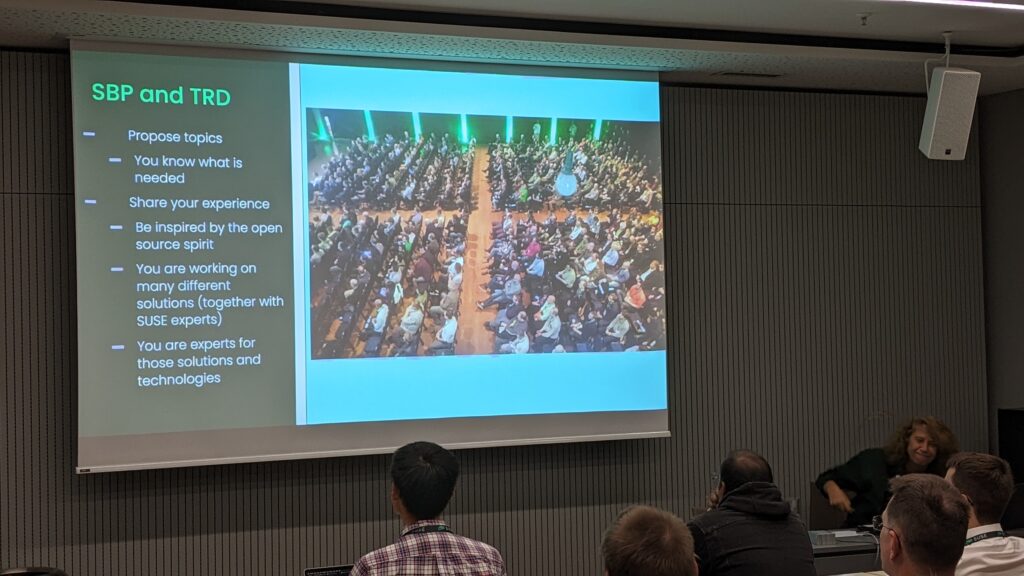It is mid-June, and I have the opportunity with my colleague Arnaud Berbier to go to Berlin. Not for visiting the city, not for sightseeing, but for a business conference. This year, SUSECON set its location in the German capital, and as a partner, it was a kind of must for dbi services to be next to SUSE.
SUSECON, the annual global conference organized by SUSE, is a convention for IT professionals like us to explore the latest developments in open-source software and SUSE technologies. This event features keynotes, technical sessions, and hands-on labs, providing a platform for learning, networking, and collaboration.

Just the time to arrive in front of the Estrel building, we were warmly welcomed by Nico Lamberti, Partner Executive ALPS at SUSE. A quick photo, and we headed inside the building. Then we met Emiel Brok. A quick chat, and he already pointed the mic to me, and we started a short interview. I’m quite shy (so I won’t put any link to it .. sorry Emiel 🙂 ) and not used to such an improvised kind of speaking, but I knew I had to push through my hesitation for this important event!
The registration desk then, and all was well organized. Step by step, we registered, changed to the following desk to get our badge, and another desk to get our swag bag. Finally, we were fully prepared for the event.
The partner summit was going to happen at 2 p.m. So we had time to attend a session.
“How YOU can contribute to high-quality documentation”
This was the first session I attended. Led by Meike Chabowski, I was interested in how SUSE was driving their documentation. Which kind of technology, which kind of organization,
She highlighted first the goal of documentation (at least at SUSE): to produce and deliver high quality documentation. What for? To provide added value, to drive custom, partner, and community (yes, open-source philosophy is there). And then she enumerated first the different sort of documentation at SUSE:
- Release notes, for a brief description of new technologies and features,
- Technical Reference Documentation, to describe and explain design, setup and configuration of SUSE products,
- SUSE Best Practices, practical, issue-focused, and solution-focused documentation,
- Product documentation, aka Technical documentation for all products,
- Topic based article.

I was really curious how SUSE manage their documentation. At dbi services, in the DevOps team, and even for personal documentation or notes based system, we use Markdown.
At SUSE, they use DocBookXML and AsciiDoc. While the first is a derivative of XML for documentation purpose, I see the second as very close to Markdown at first glance. They use XSLT stylesheets for defining the layout.
In term of infrastructure, documentation requests are managed through Jira or Bugzilla, and everything is versioned in git.
What I liked is how she highlighted contribution. We evolve in an open-source environment, and contributing is one key aspect. Working on the documentation is one way to contribute, and it’s a great way to give back to the community. This can be done quite easily. You can either report an issue in the SUSE Best Practices or Technical Reference Documentation, or propose your change to the Product documentation. Once reviewed, and maybe approved, your changes will be included.

Exploring the Technology showcase
In between sessions and talks, I spent time in the technology showcase, which was a hub of activity. Booths from various exhibitors showcased cutting-edge technologies, solutions, and products. I had the chance to speak with some exhibitors, had for instance a great detailed description of what is Confidential Computing (encryption EVERYWHERE, even the memory is encrypted on the fly!). This place was also a good opportunity to meet people, whether you knew them or not.


![Thumbnail [90x90]](https://www.dbi-services.com/blog/wp-content/uploads/2025/05/martin_bracher_2048x1536.jpg)
![Thumbnail [90x90]](https://www.dbi-services.com/blog/wp-content/uploads/2024/04/SIT_web.png)
![Thumbnail [90x90]](https://www.dbi-services.com/blog/wp-content/uploads/2024/03/AHI_web.jpg)
chabow
25.09.2024Hey Jean-Philippe! By chance, I came across your blog on the first day of SUSECON 2024. What a lovely review – thank you. I'm very happy if you enjoyed the session and were able to take something away for yourself. Best regards! Meike
Hi Meike!:) Happy you enjoyed! I have tried to transmit my feedback without altering the content of your presentation or the overall event. Hope to see you again in real!